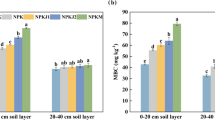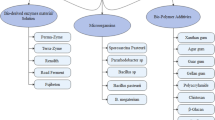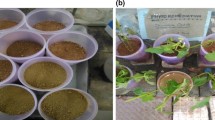Abstract
The influence of oil pollution caused by the accident of 1994 on the biological activity of Histic Cryosols is considered. Despite the use of complex mechanical (oil removal), physicochemical (washing on special devices), and agrotechnical (fertilization, plowing, grass sowing) reclamation techniques, the residual content of oil hydrocarbons in the soils can reach high values. The disturbance of the natural peat soil horizon during the reclamation procedures reduces the respiratory activity, as well as the potential rate of consuming the substrates, plant residues and water-soluble organic matter, which decreases the carbon cycle rate.




Similar content being viewed by others
REFERENCES
T. P. Alekseeva, T. I. Burmistrova, L. D. Stkahina, and N. N. Tershchenko, “Efficiency of ameliorants based on activated peat for remediation of oil-polluted soils,” Vestn. Tomsk. Gos. Univ., Biol., No. 2, 43–51 (2013).
A. A. Vershinin, A. M. Petrov, D. V. Akaikin, and Yu. A. Ignat’ev, “Assessing the biological activity of oil-contaminated soddy-podzolic soils with different textures,” Eurasian Soil Sci. 47, 134–139 (2014). https://doi.org/10.1134/S1064229314020124
A. N. Gennadiev and Yu. I. Pikovskii, “ The maps of soil tolerance toward pollution with oil products and polycyclic aromatic hydrocarbons: methodological aspects,” Eurasian Soil Sci. 40, 70–81 (2007).
N. A. Kireeva, V. V. Vodop’yanov, and A. M. Miftakhova, Biological Activity of Oil-Polluted Soils (Gilem, Ufa, 2001) [in Russian].
N. A. Kireeva, G. R. Rafikova, T. N. Shchemelina, and M. Yu. Markarova, “Biological activity of oil-polluted and reclaimed peat gley soils of the Komi Republic,” Agrokhimiya, No. 8, 68–75 (2008).
L. L. Shishov, V. D. Tonkonogov, I. I. Lebedeva, and M. I. Gerasimova, Classification and Diagnostic System of Russian Soils (Oikumena, Smolensk, 2004) [in Russian].
A. V. Kurakov, V. V. Il’inskii, S. V. Kotelevtsev, and A. P. Sadchikov, Bioindication and Rehabilitation of Ecosystems after Oil Pollution (Grafikon, Moscow, 2006) [in Russian].
M. I. Makarov, M. S. Shuleva, T. I. Malysheva, and O. V. Menyailo, “Solubility of the labile forms of soil carbon and nitrogen in K2SO4 of different concentrations,” Eurasian Soil Sci. 46, 369–374 (2013). https://doi.org/10.1134/S1064229313040091
M. I. Makarov, O. S. Mulyukova, T. I. Malysheva, and O. V. Menyailo, “Influence of drying of the samples on the transformation of nitrogen and carbon compounds in mountain-meadow alpine soils,” Eurasian Soil Sci. 46, 778–787 (2013). https://doi.org/10.1134/S1064229313070053
M. Yu. Markarova, Candidate’s Dissertation in Biology (Perm, 1999).
M. N. Maslov and M. I. Makarov, “Transformation of nitrogen compounds in the tundra soils of Northern Fennoscandia,” Eurasian Soil Sci. 49, 757–764 (2016). https://doi.org/10.1134/S1064229316070073
E. N. Melekhina, M. Yu. Markarova, T. N. Shchemelinina, E. M. Anchugova, and V. A. Kanev, “Secondary successions of biota in oil-polluted peat soil upon different biological remediation methods,” Eurasian Soil Sci. 48, 643–653 (2015). https://doi.org/10.1134/S1064229315060071
E. S. Mil’ko and N. S. Egorov, Heterogeneity of Bacterial Population and Dissociation Process (Moscow State Univ., Moscow, 1991) [in Russian].
Yu. I. Pikovskii, A. N. Gennadiev, S. S. Chernyanskii, and G. N. Sakharov, “The problem of diagnostics and standardization of the levels of soil pollution by oil and oil products,” Eurasian Soil Sci. 36, 1010–1017 (2003).
N. P. Tarabukina, D. D. Savvinov, M. M. Neustroev, A. M. Stepanova, M. P. Neustroev, N. N. Sazonov, and S. I. Parnikova, Ecological Evaluation and Bioremediation of Oil-Polluted Permafrost-Affected Soils of Yakutia (SibAK, Novosibirsk, 2017) [in Russian].
Ecological Standardization and Quality Control of Soils and Lands (NIA-Priroda, Moscow, 2013) [in Russian].
E. A. Asquith, P. M. Geary, and A. L. Nolan, “Comparative bioremediation of petroleum hydrocarbon-contaminated soil by biostimulation, bioaugmentation, and surfactant addition,” J. Environ. Sci. Eng. 1, 637–650 (2012).
Bioremediation of Petroleum Hydrocarbons in Cold Regions (Cambridge University Press, Cambridge, 2008).
W. Chang, M. Dyen, L. Spagnuolo, Ph. Simon, L. Whyte, and S. Ghoshal, “Biodegradation of semi- and non-volatile petroleum hydrocarbons in aged, contaminated soils from a sub-Arctic site: Laboratory pilot-scale experiments at site temperatures,” Chemosphere 80, 319–326 (2010).
IUSS Working Group WRB, World Reference Base for Soil Resources, World Soil Resources Reports No. 103 (Food and Agriculture Organization, Rome, 2006).
R. Margesin, A. Zimmerbauer, and F. Schinner, “Monitoring of bioremediation by soil biological activities,” Chemosphere 40 (4), 339–346 (2000).
W. W. Mohn and G. R. Stewart, “Limiting factors for hydrocarbon biodegradation at low temperature in Arctic soils,” Soil Biol. Biochem. 32, 1161–1172 (2000).
Y.-S. Oh, W.-Y. Choi, Y.-H. Lee, S.-C. Choi, and S.‑J. Kim, “Biological treatment of oil-contaminated sand: comparison of oil degradation based on thin-layer chromatography/flame ionization detector and respirometric analysis,” Biotechnol. Lett. 22, 595–598 (2002).
M. E. Ramirez, B. Zapien, H. G. Zegarra, N. G. Rojas, and L. C. Fernandez, “Assessment of hydrocarbon biodegradability in clayed and weathered polluted soils,” Int. Biodeterior. Biodegrad. 63, 347–353 (2009).
D. Sanscartier, T. Laing, K. Reimer, and B. Zeeb, “Bioremediation of weathered petroleum hydrocarbon soil contamination in the Canadian High Arctic: Laboratory and field studies,” Chemosphere 77, 1121–1126 (2009).
E. D. Vance, P. C. Brookes, and D. S. Jenkinson, “An extraction method for measuring soil microbial biomass C,” Soil Biol. Biochem. 19, 703–707 (1987).
A. Wolińska, A. Kuźniar, A. Szafranek-Nakonieczna, N. Jastrzębska, E. Roguska, and Z. Stępniewska, “Biological activity of autochthonic bacterial community in oil-contaminated soil,” Water, Air Soil Pollut. 227, 130 (2016).
ACKNOWLEDGMENTS
This work was supported by the grant of President of the Russian Federation (project no. MK-1996.2017.5). The authors thank M.I. Makarov, Head of the Department of Soil Science of the Lomonosov Moscow State University, for the possibility to determine carbon in soil extracts.
Author information
Authors and Affiliations
Corresponding author
Additional information
Translated by L. Kholopova
Rights and permissions
About this article
Cite this article
Maslov, M.N., Maslova, O.A. & Ezhelev, Z.S. Microbiological Transformation of Organic Matter in Oil-Polluted Tundra Soils after Their Reclamation. Eurasian Soil Sc. 52, 58–65 (2019). https://doi.org/10.1134/S1064229319010101
Received:
Revised:
Accepted:
Published:
Issue Date:
DOI: https://doi.org/10.1134/S1064229319010101




